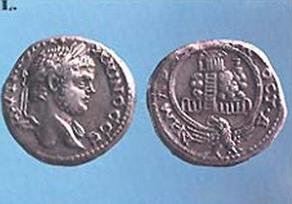Shechem City Coin, 207-212 CE
Shechem City Coin
During the Roman period, gold and silver coins minted in Rome, as well as bronze coins minted in a number of Palestinian cities, were used in the Holy Land. Indeed, over thirty cities on both sides of the Jordan minted bronze coins, principally during the 2nd and 3rd centuries A.D. Known as “city coins,” these coins are of great historical importance, because they provide our only information about some of these cities. Religious, political, cultural and economic backgrounds can be deduced from their designs and inscriptions. Even landscapes and architectural elements can be reconstructed. Thus, recent excavations on Mt. Gerizim near Shechem uncovered coins struck in Shechem. These coins depict Mt. Gerizim with its temples, altars and buildings so accurately that these coins provide a geographical map of the ancient site.
This highly detailed tetradrachma was struck in Neapolis (Biblical Shechem) by the Roman Emperor Caracalla (207–212 A.D.) The fanciful illustration on the right is of the Temple of Zeus built by Hadrian on top of the holy mountain, Gerizim. A portion of the monumental staircase leading up to the temple has recently been discovered.
Some of the statues depicted on various “city coins” have been found in excavations; statuary fragments can now be reconstructed with the help of these coins. Recently, the huge statue of the Tyche of Caesarea has been unearthed in excavations. The statue is broken and some parts are missing, including a small “harbor god” originally attached to the statue. The complete statue is depicted on various coins of Caesarea from the 2nd and 3rd centuries A.D. from which we can reconstruct the precise shape of this monument.
Unfortunately, the minting of these “city coins” was stopped by the Romans in about 265 because of a dramatic monetary change in the Roman empire. After that, no coins were minted in the Holy Land until the Arab invasion in the 7th century.




